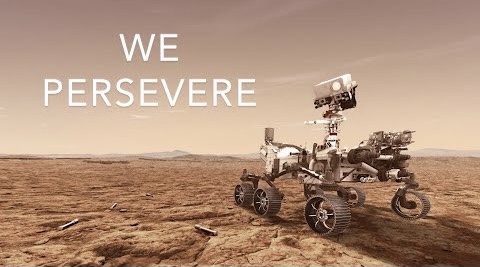Perseverance Rover Landing: Another Step for Mankind

NASA’s Perseverance rover has successfully landed on Mars and will soon begin to search for signs of ancient life.
February 19, 2021
Thursday, February 18, 2021, just before 4 p.m. EST, NASA’s Perseverance Rover initiated its descent towards Mars’ surface after traveling 293 million miles through space. The spacecraft holding the rover began its entry, descent, landing (EDL) sequence, where each part of the sequence would need to be executed perfectly for a successful landing. With the help of parachutes, retrorockets, and lowering cables, Perseverance was safely lowered to the ground in the Jezero Crater, where it sent its first picture to NASA’s Jet Propulsion Laboratory, confirming its arrival on the Red Planet.
Perseverance is currently NASA’s largest and most advanced rover. It is equipped with 23 cameras, a robotic arm, tools for collecting rock samples, and a microphone. According to Space.com, this is not the first time a microphone has been brought to Mars, but it is the first time the microphone will be used to record sounds during a rover’s EDL sequence mission on Mars. Perseverance also holds a helicopter-like drone called Ingenuity, which will be the first flying device to be tested on Mars. Tests will evaluate how a rotorcraft will fly in the thin Martian atmosphere and if it can survive the harsh temperatures at night. If all goes well, Ingenuity will provide NASA with another tool for the exploration of the planet.
After the Curiosity rover discovered water on Mars in 2012, researchers at NASA are now looking for signs of extraterrestrial life. The Jezero Crater where Perseverance landed was once a river delta that dried up 3.4 billion years ago. Tanja Bosak, a geobiologist working on the Perseverance mission, states that “in the ancient dried clay of the delta, there may be microscopic fossils of microbial life, or geological pattern indicative of life.” Perseverance will also be storing samples of rock that are planned to be sent back to Earth on a future mission. The samples will hopefully guide scientists to the answers to questions concerning the creation of life on both Earth and Mars. Analise Hopper (10) hopes that with the new technology, “Perseverance can help researchers at NASA find signs of life on Mars because [she] was curious about it since [she] was young.”
In addition to being a monumental tool for the exploration of Mars, Perseverance serves as an inspiration to humans. Past rovers that have traveled to Mars have been named after human qualities, such as Curiosity and Spirit. Similarly, the name Perseverance, chosen by Alexander Mather in an essay-writing contest, embodies a characteristic that keeps humans going no matter how difficult something is. This quality has been especially important throughout the past year with the coronavirus pandemic, where people were faced with hardships they have never seen before. However, despite the difficulties, people have kept going and overcome obstacles that have led to achievements such as Perseverance’s landing. Anything is possible if we never give up because, just as the rover’s first tweet from Mars says, “Perseverance will get you anywhere.”





















Emma Perron • Feb 28, 2021 at 11:17 AM
I have heard about this rover since the start and this article is amazing. It is such an important topic to write about and educate people about.
Nikole Galea • Feb 28, 2021 at 9:23 AM
Hi Tiana, great article! I can’t wait to see what new information that the rover provides scientists and us with. Hopefully it helps us get closer to an understanding of the planets.
faith desio • Feb 26, 2021 at 10:37 PM
Wow, great job on this article Tiana! It is so crazy to think that we are slowly making our way onto another planet. I find it so interesting to read about the technological advancements we have made over the past years!
Anita Tun • Feb 22, 2021 at 9:59 AM
It is insane how fast technology is evolving, not too long ago we took our first steps to the moon. It’s cool seeing NASA’s inventions that take years to make.
Paige Reddick • Feb 21, 2021 at 8:19 PM
I just saw a video clip from this rover of Mars. It’s crazy how amazing technology is. Thank you for sharing!
Suhani Bhanvadia • Feb 21, 2021 at 11:39 AM
Great article! Especially after seeing the advances between each rover, it will be super interesting to see what NASA finds.
Nikole Galea • Feb 21, 2021 at 11:20 AM
Great article Tiana, this is a great topic and a huge step for humans. You formed the article to make it very easy to follow and smooth. Great job!
Katelyn Ruggles • Feb 21, 2021 at 12:15 AM
Tiana, I love that you wrote this article. This is such a huge accomplishment for Nasa! I think it is really cool how the rover is even using social media like twitter to communicate with people.
Sharon Sun • Feb 20, 2021 at 3:27 PM
Hey Tiana, I think the landing onto Mars is an exciting step for NASA’s space research! I also agree with Analise — as someone also interested in the existence of life in space, I’m hoping that Perseverance uncovers something as well.